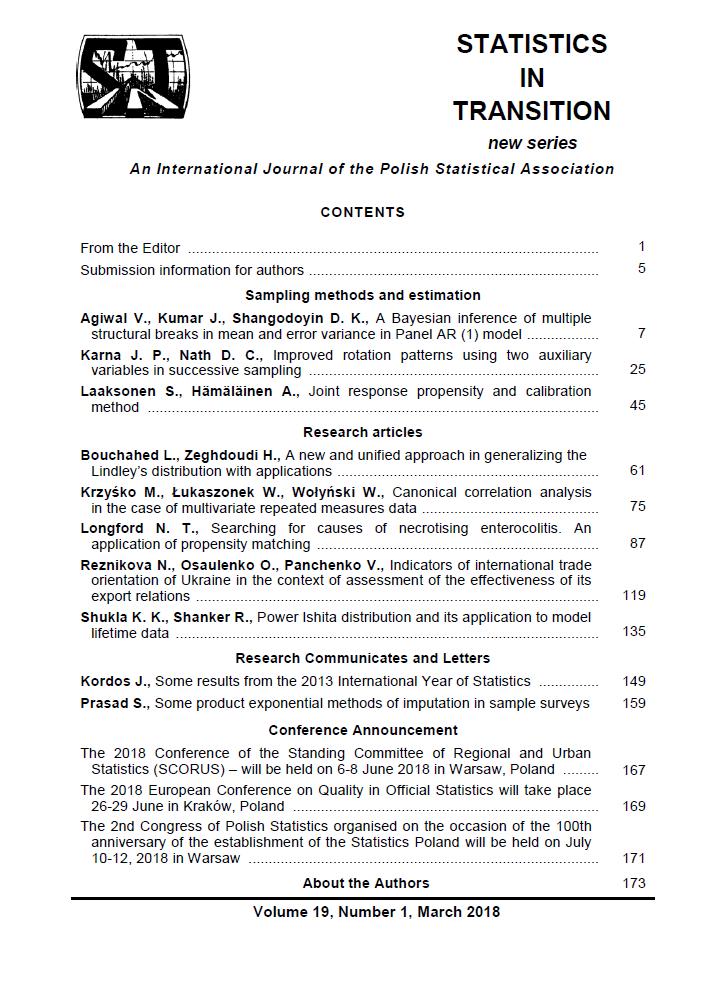ARTICLE
ABSTRACT
The present paper emphasizes the role of two auxiliary variables on both the occasions to improve the precision of estimates at the current (second) occasion in two-occasion successive sampling. Information on two auxiliary variables, which are positively correlated with the study variable, has been used with the aid of exponential type structures and an efficient estimation procedure of population mean on the current (second) occasion has been suggested. The behaviour of the proposed estimator has been studied and compared with the sample mean estimator, when there is no matching from the previous occasion and natural successive sampling estimator, which is a linear combination of the means of the matched and unmatched portions of the sample at the current (second) occasion. Optimal replacement strategy is also discussed. The concluding remarks are discussed justifying utility of the proposed sampling scheme. The results have been well supported analytically as well as empirically by using real life data.
KEYWORDS
exponential type estimators, bias, mean squared error, optimum replacement strategy
REFERENCES
BEEVI, N. T., CHANDRAN, C., (2017). Efficient family of ratio-type estimators for mean estimation in successive sampling using auxiliary information on both occasions. Statistics In Transition – New Series, 18 (2), pp. 227–246.
BIRADAR, R. S., SINGH, H. P., (2001). Successive sampling using auxiliary information on both occasions. Cal. Statist. Assoc. Bull. 51, pp. 243–251.
CENSUS OF INDIA, (2001). www.cesusindiagov.in.
CENSUS OF INDIA, (2011). www.cesusindiagov.in.
CHATURVEDI, D. K., TRIPATHI, T. P., (1983). Estimation of population ratio on two occasions using multivariate auxiliary information. Journal of Indian Statistical Association 21, pp. 113–120.
COCHRAN, W. G., (1977). Sampling Techniques, Wiley Eastern Limited, New Delhi, III Edition.
DAS, A. K., (1982). Estimation of population ratio on two occasions, Jour Ind. Soc. Agr. Statist. 34, pp. 1–9.
FENG, S., ZOU, G., (1997). Sample rotation method with auxiliary variable. Communications in Statistics-Theory and Methods, 26 (6), pp. 1497–1509.GUPTA, P. C., (1979). Sampling on two successive occasions. Jour. Statist. Res. 13, pp. 7–16.
JESSEN, R. J., (1942). Statistical Investigation of a Sample Survey for obtaining farm facts, Iowa Agricultural Experiment Station Research Bulletin No. 304, Ames, Iowa, USA, pp. 1–104.
KARNA, J. P., NATH, D. C., (2016). Rotation sampling scheme using transformed auxiliary variable. Journal of Statistics & Management Systems, 19 (6), pp. 739–754.
PATTERSON, H. D., (1950). Sampling on successive occasions with partial replacement of units, Journal of the Royal Statistical Society, 12, pp. 241–255.
RALTE, Z., DAS, G., (2015). Ratio-to-regression estimator in successive sampling using one auxiliary variable. Statistics in Transition – new series, 16 (2), pp. 183–202.
RAO, J. N. K., GRAHAM, J. E., (1964). Rotation designs for sampling on repeated occasions, Journal of the American Statistical Association, 59, pp. 492–509.
REDDY, V. N., (1978). A study on the use of prior knowledge on certain population parameters. Sankhya, 40, C, pp. 29–37.
SEN, A. R., (1971). Successive sampling with two auxiliary variables, Sankhya, 33, Series B, pp. 371–378.
SEN, A. R., (1972). Successive sampling with p ?p 1 ? ? auxiliary variables, Ann. Math. Statist., 43, pp. 2031–2034.
SEN, A. R., (1973). Some theory of sampling on successive occasions, Australian Journal of Statistics, 15, pp. 105–110.
SINGH, G. N., (2005). On the use of chain-type ratio estimator in successive sampling, Statistics in Transition, 7, pp. 21–26.
SINGH, G. N., KARNA, J. P., (2009a). Estimation of Population mean on the current in two-occasion successive sampling. Metron, 67(1), 2009, pp. 87–103.
SINGH, G. N., KARNA, J. P., (2009b). Search of effective rotation patterns in presence of auxiliary information in successive sampling over two occasions. Statistics in Transition-new series, 10, pp. 209, 59–73.
SINGH, H. P., PAL, S. K., (2015). An efficient effective rotation pattern in successive sampling over two occasions. Communication in Statistics: Theory and Methods, 45 (17), pp. 5017–5027.
SINGH, H. P., PAL, S. K., (2017). A class of exponential type estimators of a general parameter. Communication in Statistics – Theory and Methods, 46 (8), pp. 3957–3984.
SUKHATME, P. V., SUKHATME, B. V., SUKHATME, S., ASOK, C., (1984).Sampling theory of surveys with applications. Iowa State University Press, Ames, Iowa (USA) and Indian Society of Agricultural Statistics, New Delhi (India),III Revised Edition.
UPADHYAYA, L. N., SINGH, H. P., CHATTERJEE, S., YADAV, R., (2011).Improved ratio and product exponential type estimators. J. Stat. Theo. Pract.5 (2), pp. 285–302.
YADAV, S. K., KADILAR, C., (2013). Improved exponential type ratio estimator of population variance. Revis. Colum. de Estadist. 36 (1), pp. 145–152
